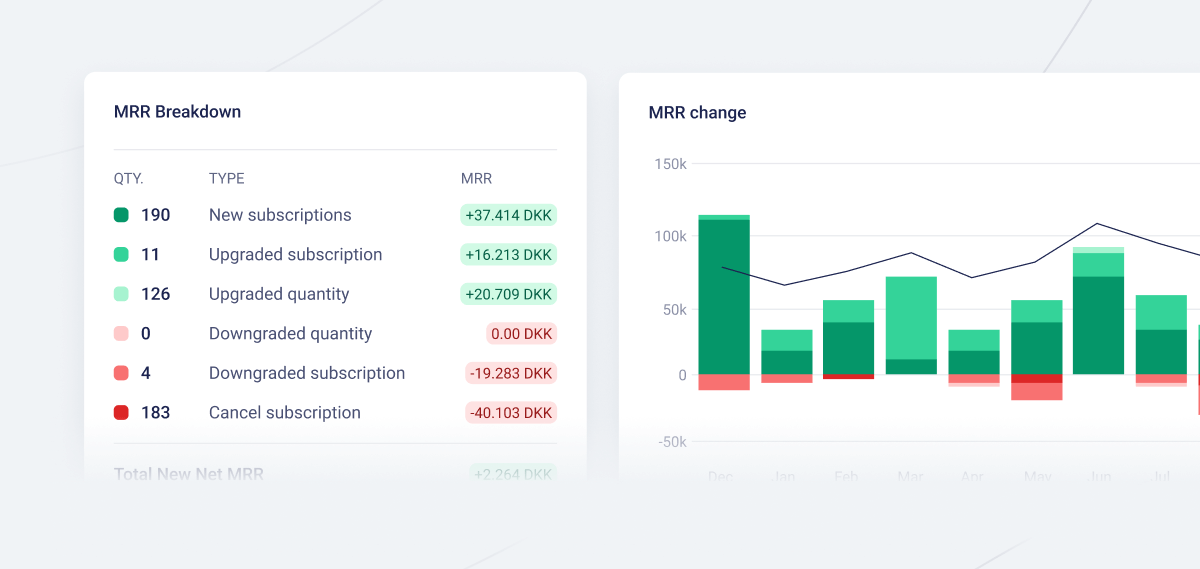What is MRR?
MRR Meaning
At its core, MRR (Monthly Recurring Revenue) is the total amount of predictable revenue that a business can expect on a monthly basis from active subscriptions. It's a vital indicator of a company's financial health, as it accounts for the consistent revenue generated by customers over time, excluding any one-time payments or irregular revenue streams. This metric provides a clear picture of the company's performance and helps in forecasting future growth.
 Fenerum dashboard showing SaaS MRR and MRR Breakdown.
Fenerum dashboard showing SaaS MRR and MRR Breakdown.
Importance of MRR in SaaS
Why MRR is Crucial for SaaS Businesses
MRR SaaS is fundamental because it offers a reliable snapshot of a company’s financial standing. This predictability is crucial for planning, budgeting, and making informed business decisions. For SaaS companies, which rely heavily on the subscription model, tracking MRR is a way to measure the business’s success and scalability.
The difference between MRR and Revenue
While MRR focuses specifically on the recurring monthly revenue from subscriptions, overall revenue encompasses all income generated by the business. This includes one-time sales, professional service fees, and any other non-recurring revenue streams. Understanding the distinction between MRR and total revenue is crucial for accurate financial analysis and forecasting.
- MRR (Monthly Recurring Revenue): Is your potential earnings every month.
- Total Revenue: Is your realized earnings in a given period.
Subscription Management and MRR
Subscription management plays a pivotal role in maintaining and growing MRR. Effective subscription management ensures that customers have a seamless experience, from onboarding to payment processing. This includes handling renewals, upgrades, downgrades, and churn. By efficiently managing these aspects, SaaS businesses can maximize their MRR and reduce revenue loss from customer attrition.
Calculating MRR
How to Calculate MRR
The basic formula for calculating MRR is straightforward:
MRR = (Total Number of Customers) × (Average Revenue Per User)
For example, if a SaaS company has 100 customers each paying $50 per month, the MRR would be:
MRR = 100 customers x $50 per customer = $5000
However, it’s important to account for various factors that can affect MRR, such as new customers, churn, expansions, and contractions.
Components of MRR
- New MRR: Revenue generated from new customers.
- Net MRR change: The growth or decline in revenue compared to the previous month.
- Expansion MRR: Revenue from contract upsells, cross-sells, and add-ons.
- Upgrade MRR: Revenue from subscriptions upgraded to a higher pricing tier.
- Contraction MRR: Revenue lost due to discounts etc.
- Downgrade MRR: Reduced revenue from subscriptions downgraded to a lower pricing tier.
- Reactivation MRR: Revenue from churned customers who returned to a paid plan.
- Churn MRR: Revenue lost due to subscription cancellations from month to month.
MRR Variations and Considerations
For more granular insights, companies often track different types of MRR:
- Current MRR: Your total MRR right at this moment, not including scheduled activities
- End of month MRR: If nothing changes this will be your MRR at the very end of the month.
- Committed MRR: Total MRR including all scheduled activities.
- Annual Recurring Revenue (ARR): MRR multiplied by 12 to project annual revenue.
Strategies to Increase SaaS MRR
Enhancing Customer Retention: One of the most effective ways to boost MRR SaaS is by enhancing customer retention. Loyal customers are more likely to continue their subscriptions, upgrade to higher-tier plans, and recommend the service to others.
Upselling and Cross-Selling: Upselling existing customers to higher plans or cross-selling additional features can significantly increase MRR. This involves understanding customer needs and providing value-added solutions that enhance their experience.
Reducing Churn: Reducing churn is crucial for maintaining and growing MRR. This can be achieved by improving customer support, addressing pain points, and offering incentives for long-term commitments.
Expanding Market Reach: Expanding the customer base by entering new markets or targeting new customer segments can also drive MRR growth. This requires strategic marketing and tailored offerings that resonate with the new audience.
Conclusion
Understanding and optimizing Monthly Recurring Revenue (MRR) is essential for the success of SaaS businesses. By focusing on effective subscription management, enhancing customer retention, and implementing strategic growth initiatives, companies can maximize their MRR and ensure long-term sustainability. Tracking MRR SaaS provides invaluable insights into the financial health of the business, enabling better decision-making and more predictable growth.
